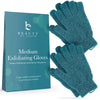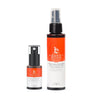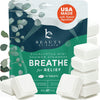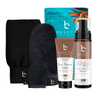
As a mother of 3 boys—ages 4 to 9 years—mineral sunscreen is an essential staple in my home. Finding a mineral sunscreen that my kids won't squeal and scream about is sheer bliss! Here's my tried-and-true mom's guide to the absolute best kid-friendly mineral sunscreen.
Why Mineral Sunscreen for Kids?
In case, like me, you missed the memo, here's a friendly heads up. SUMMER HAS ARRIVED! Yes, we've all been stuck sheltering at home indoors for the past 6+ weeks, spring wasted away unattended. Now summer has jumped in and stolen the show.

My ignorance of summer's sudden appearance is causing me lots of pain at the moment. This morning, I took our family Goldendoodle on a 20-minute walk without applying sunscreen. "It'll be so quick; I don't need sunscreen," I naively reassured myself as I grabbed her leash and hopped out the door. BIG mistake.
I came home with violently red shoulders and a vaguely nauseous feeling I've grown to associate with summers in Texas.
Summer is here, friends, and it's time to stock up on sunscreen. So, you're probably asking, "why mineral sunscreen?"

Here're the quick deets:
1: Mineral sunscreen doesn't put toxins into your bloodstream.
Most chemical sunscreens use active ingredients such as oxybenzone, octinoxate, and homosalate. If you're like me and don't currently have a medical degree, let me help you out with these ingredients.
Oxybenzone – Hormone disruption + in addition to high rates of skin allergies, it acts like estrogen in the body, alters sperm production in animals and has been associated with endometriosis in women. It penetrates through the skin and studies have found it present in mother’s milk of nursing mothers.

Octinoxate (otherwise called Octylmethoxycinnamate) – moderate skin allergies are connected, in addition to alteration of hormone activity, reproductive issues, and thyroid and behavioral alterations in animal studies.
Homosalate – disrupts natural hormones – estrogen, androgen, and progesterone.
You can see a much deeper look at toxins in chemical sunscreens in our post here.

In a recent study published in the Journal of the American Medical Association, four common ingredients found in chemical sunscreen were found to be absorbed by your bloodstream at significantly high levels (higher than 0.5 ng/mL). As the authors of the study observe,
The US Food and Drug Administration (FDA) has provided guidance that sunscreen active ingredients with systemic absorption greater than 0.5 ng/mL or with safety concerns should undergo nonclinical toxicology assessment including systemic carcinogenicity and additional developmental and reproductive studies.
Effect of Sunscreen Application Under Maximal Use Conditions on Plasma Concentration of Sunscreen Active IngredientsA Randomized Clinical Trial
In other words, your kids' bodies are absorbing a lot of potential toxins when you spray/slather them with chemical sunscreen.
2: Mineral sunscreen has ZERO lag time between application & protection.
You heard me right. Unlike its chemical counterparts, with mineral sunscreen, you can apply and then instantly hit the waves. With little ones who are just itching to swim, this is a BIG BONUS!
3: Mineral sunscreen protects your skin against the harm of ultraviolet rays.

While chemical sunscreens filter out UV rays, mineral-based sunscreens physically block them altogether. Accordingly, mineral sunscreens made from ingredients like zinc oxide historically tended to be thicker and harder to apply. Times have changed, though, my friends. Now you can buy sunscreens with non-nano (hear "itty bitty particles") that rub in easily without the white-sheet look.
4: Mineral sunscreen is reef-friendly!
If you're planning a trip to the beach this summer, make sure you're packing sunscreen that's reef -friendly. Both Hawaii and California have banned all sunscreens containing reef-bleaching chemicals: oxybenzone and octinoxate. For a while now, researchers have believed these two bad boys to be harmful to marine habitats.
And when I say "harmful," I mean turning this:
to this:

This devastation of our ocean's reefs has only further solidified my devotion to mineral alternatives for protecting mine and my kids' skin. Non-nano minerals give your kids' protection from UVA/UVB rays without hurting our oceans.
The Best Mineral Sunscreen for Kids
You guys, I've tried them all. The ones that turn you ghostly pale. The ones that take 5-hours to rub in properly. Yeah, those ones. . .
The ones that smell like a pina-colada mixed with 11-year-old tuti-fruiti girl perfume. I've tried the expensive ones that require a small mortgage and the cheapies. I've literally spent hours online comparing user ratings and reviews and trying to get the perfect sunscreen. And, lucky for you, I've found my forever favorite!
Here is why my kids and I love Beauty by Earth's Mineral Sunscreen:
- Light-weight and doesn't make you ghostly-pale (It's a made from uncoated Zinc Oxide (Non-nano)….14%)
- Water-resistant for up to 80 minutes
- A subtle scent that even my husband likes.
- Rubs in quickly and easily

- Protects like a charm!
- Great ingredients — there are so many great ingredients in BBE's sunscreen, like Aloe Vera, Argan Oil, Jojoba Oil, Coconut Oil, Shea Butter, Cucumber Extract, and Green Tea Extract.
- It comes in regular, facial, and tinted facial! Granted, my kids don't really care one way or the other about this, but for me, it's a big plus! The facial sunscreen is so light-weight, doesn't make me breakout, and still protects my skin from harsh rays.
You can check out the full line of Beauty by Earth sun care products here.
Surf, sea-salted hair, and lots of mineral sunscreen,
Jenny





















































































join the conversation